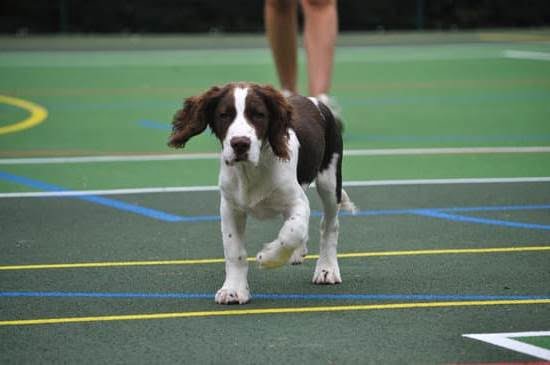Introduction
Training a dog can vary drastically in complexity and duration, depending on the type of training. For example, puppy training typically takes 4 to 8 weeks and consists of crate training, housebreaking, socialization, and basic commands such as sit, stay, come and down. More involved obedienceTraining might include agility courses or protection work. This could take anywhere from two months to a year depending on the level of difficulty set by the trainer. Additionally, a consistent regime of regular exercise and reinforcement is necessary for dogs to retain their behavior especially if they are not constantly being trained with new tricks.
Types of Training
Training a dog typically depends on the breed and age. Generally speaking, obedience training can take anywhere from 4-8 weeks, while potty training can take from a few days to several weeks. However, some breeds tend to take much longer to train than others do.
Obedience classes typically involve reward-based training. This involves rewards for desired behaviors such as treats or words of praise. Dog owners should be consistent with commands and determine one word for each command (sit, stay, come). Using one word for each command ensures that the dog doesn’t get confused between multiple commands. Additionally, it is important to remain patient as puppy behavior can often seem unpredictable initially.
Agility classes are another type of training offered by many schools. These classes focus on teaching agility maneuvers such as weaving through obstacles or jumping through hoops and over hurdles. Agility courses also include controlled conditions where time limits need to be adhered to by the dog in order to pass each element of the course. Dog owners should ensure they provide positive reinforcement when their pup completes the tasks correctly in order to build their confidence in running the course.
Protection/guardian training also falls under this category and is generally done on an individual basis with an experienced trainer due to its intensity level and amount of repetition required for mastery of all exercises. During suchtraining sessions, drills are repeatedly practiced and additional homework may be assigned for reinforcement outside of class hours by the instructor in order for a pup’s skillset to reach its maximum potential. Positive rewards should still be administered during reinforcement periods – though more reinforced corrections may also need to be implemented during higher levels of difficulty drills encountered at later stages in this type of coursework program progression format throughout completion.
Factors that Impact the Length of Training
Age can have a major impact on the length of time for training a dog. Generally speaking, puppies are more impressionable and more resilient to new experiences. This means that puppies can learn basic commands much faster than older dogs. However, puppies may also require more attention during the training process, since they are often still learning how to socialize and behave properly around people and other animals.
Temperament also has an effect on how long it takes to train a dog. For example, some breeds may respond better to repetitive training practices or be more eager to learn basic commands, while others may be slower to adapt. As a result, it is important to take the dog’s temperament into account when deciding how long it will take for it to learn new behaviors or skills. Additionally, a dog’s past experiences and exposure to different environments may also play a role in their responsiveness and capability of learning quickly when training begins.
Estimating How Long it Takes to Train a Dog
The amount of time it takes to train a dog depends on several factors such as: the breed, age, and skillset of the dog in question; the type of training being done; the environment in which it’s occurring (such as distractions or lack thereof) and the consistency with which the training program is adhered to. For example, dogs can be trained using positive reinforcement, operant conditioning (including clicker training), aversion therapy/dominance-based methods – all of which may take different amounts of time.
In general, housebreaking can take anywhere from a few days up to a month depending on the individual dog’s temperament and capacity for learning. Basic commands such as sit and stay may range anywhere from two weeks up to two months when utilizing positive reinforcement-based approaches. Further specialized training such as agility or protection could take months or even years. Ultimately, every situation is unique – some dogs may pick up new skills quickly while others require more patience and potentially multiple attempts before mastering a command. Ultimately, consistency is key in successful effective dog-training!
Additional Considerations
It is important to establish a strong bond between the dog and their owner, as this will help create an environment of trust during training. The trust and bond created through positive reinforcement can help make the training process easier as the dog becomes more eager to learn and engage. This helps to reduce anxiety levels in dogs by allowing them to achieve desired outcomes with consistent positivity. In turn, they are less likely to shut down when presented with something difficult or frustrating, providing an ideal learning environment. Training should also be seen as an ongoing process where regular practice is essential in reinforcing new behaviors and techniques. Taking the time to build a strong relationship with your pup will give you and your pet the best chance for success during the training process.
Conclusion
Training a dog takes time and patience. Generally, most dogs should have a solid understanding of basic commands in around 4-6 weeks. However, the time it takes to train a dog depends on various factors such as the breed, age, and personality of the dog. Patience and consistency are essential for successful training over any period of time.
For additional advice and resources available to help with dog training, there are many books and websites dedicated to providing guidance on all aspects of canine skills from housebreaking to teaching obedience commands. Additionally, professional trainers often offer lessons or group classes that cover basic obedience skills as well as more complex training techniques.

Welcome to the blog! I am a professional dog trainer and have been working with dogs for many years. In this blog, I will be discussing various topics related to dog training, including tips, tricks, and advice. I hope you find this information helpful and informative. Thanks for reading!





